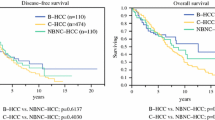Abstract
Objective
Our objective was to explore the short-term effects of preoperative serum hepatitis B virus DNA level (HBV DNA) on postoperative hepatic function in patients who underwent partial hepatectomy for hepatitis B-related hepatocellular carcinoma (HCC).
Methods
The clinical data of 1,602 patients with hepatitis B-related HCC who underwent partial hepatectomy in our department were retrospectively studied. The patients were divided into three groups according to their preoperative HBV DNA levels: group A <200 IU/mL, group B 200–20,000 IU/mL, and group C >20,000 IU/mL. The rates of postoperative complications, especially the rate of postoperative liver failure, were compared.
Results
There were significant differences among the three groups in the rates of postoperative liver failure. On multivariate logistic regression analysis, a high preoperative HBV DNA level was an independent risk factor for postoperative liver failure.
Conclusions
Preoperative HBV DNA level was a significant risk factor for postoperative hepatic dysfunction.
Similar content being viewed by others
References
El-Serag HB, Rudolph KL (2007) Hepatocellular carcinoma: epidemiology and molecular carcinogenesis. Gastroenterology 132(7):2557–2576
Bruix J, Sherman M, American Association for the Study of Liver Diseases (2011) Management of hepatocellular carcinoma: an update. Hepatology 53(3):1020–1022
Bruix J, Sherman M, Llovet JM et al (2001) Clinical management of hepatocellular carcinoma. Conclusions of the Barcelona 2000 EASL conference. European Association for the Study of the Liver. J Hepatol 35(3):421–430
Pang YY (2002) The Brisbane 2000 terminology of liver anatomy and resections. HPB 2000;2:333–39. HPB (Oxford) 4(2):99 author reply 99–100
Ishak K, Baptista A, Bianchi L et al (1995) Histological grading and staging of chronic hepatitis. J Hepatol 22(6):696–699
Mullen JT, Ribero D, Reddy SK et al (2007) Hepatic insufficiency and mortality in 1,059 noncirrhotic patients undergoing major hepatectomy. J Am Coll Surg 204(5):854–862 discussion 862–4
Yamashita Y, Hamatsu T, Rikimaru T et al (2001) Bile leakage after hepatic resection. Ann Surg 233(1):45–50
Lok AS, McMahon BJ (2004) AASLD practice guidelines. Chronic hepatitis B: update of therapeutic guidelines. Rom J Gastroenterol 13(2):150–154
Lok AS, McMahon BJ (2007) Chronic hepatitis B. Hepatology 45(2):507–539
Song TJ, Ip EW, Fong Y (2004) Hepatocellular carcinoma: current surgical management. Gastroenterology 127(5 Suppl 1):S248–S260
Detroz B, Sugarbaker PH, Knol JA et al (1994) Causes of death in patients undergoing liver surgery. Cancer Treat Res 69:241–257
Jarnagin WR, Gonen M, Fong Y et al (2002) Improvement in perioperative outcome after hepatic resection: analysis of 1, 803 consecutive cases over the past decade. Ann Surg 236(4):397–406 discussion 406–7
Simons JP, Hill JS, Ng SC et al (2009) Perioperative mortality for management of hepatic neoplasm: a simple risk score. Ann Surg 250(6):929–934
Schindl MJ, Redhead DN, Fearon KC et al (2005) The value of residual liver volume as a predictor of hepatic dysfunction and infection after major liver resection. Gut 54(2):289–296
Bertoletti A, Gehring AJ (2006) The immune response during hepatitis B virus infection. J Gen Virol 87(Pt 6):1439–1449
Klenerman P, Hill A (2005) T cells and viral persistence: lessons from diverse infections. Nat Immunol 6(9):873–879
Webster GJ, Reignat S, Maini MK et al (2000) Incubation phase of acute hepatitis B in man: dynamic of cellular immune mechanisms. Hepatology 32(5):1117–1124
Trobonjaca Z, Kroger A, Stober D et al (2002) Activating immunity in the liver. II. IFN-beta attenuates NK cell-dependent liver injury triggered by liver NKT cell activation. J Immunol 168(8):3763–3770
Rapicetta M, Ferrari C, Levrero M (2002) Viral determinants and host immune responses in the pathogenesis of HBV infection. J Med Virol 67(3):454–457
Rehermann B, Nascimbeni M (2005) Immunology of hepatitis B virus and hepatitis C virus infection. Nat Rev Immunol 5(3):215–229
Wieland SF, Chisari FV (2005) Stealth and cunning: hepatitis B and hepatitis C viruses. J Virol 79(15):9369–9380
Lau JY, Wright TL (1993) Molecular virology and pathogenesis of hepatitis B. Lancet 342(8883):1335–1340
Xie Y, Zhao H, Dai WS et al (2003) HBV DNA level and antigen concentration in evaluating liver damage of patients with chronic hepatitis B. Hepatobiliary Pancreat Dis Int 2(3):418–422
Yeo W, Johnson PJ (2006) Diagnosis, prevention and management of hepatitis B virus reactivation during anticancer therapy. Hepatology 43(2):209–220
Yeo W, Chan PK, Zhong S et al (2000) Frequency of hepatitis B virus reactivation in cancer patients undergoing cytotoxic chemotherapy: a prospective study of 626 patients with identification of risk factors. J Med Virol 62(3):299–307
Yeo W, Lam KC, Zee B et al (2004) Hepatitis B reactivation in patients with hepatocellular carcinoma undergoing systemic chemotherapy. Ann Oncol 15(11):1661–1666
Nagamatsu H, Kumashiro R, Itano S et al (2003) Investigation of associating factors in exacerbation of liver damage after chemotherapy in patients with HBV-related HCC. Hepatol Res 26(4):293–301
Zhong S, Yeo W, Schroder C et al (2004) High hepatitis B virus (HBV) DNA viral load is an important risk factor for HBV reactivation in breast cancer patients undergoing cytotoxic chemotherapy. J Viral Hepat 11(1):55–59
Jang JW, Choi JY, Bae SH et al (2006) A randomized controlled study of preemptive lamivudine in patients receiving transarterial chemo-lipiodolization. Hepatology 43(2):233–240
Funding
The State Key Project on Infectious Diseases of China: 2008ZX10002-018, 2008ZX10002-025. The Creative Research Group, National Natural Science Foundation of China (30921006, 81081778).
Author information
Authors and Affiliations
Corresponding author
Rights and permissions
About this article
Cite this article
Huang, G., Lau, W.Y., Shen, F. et al. Preoperative Hepatitis B Virus DNA Level is a Risk Factor for Postoperative Liver Failure in Patients Who Underwent Partial Hepatectomy for Hepatitis B-Related Hepatocellular Carcinoma. World J Surg 38, 2370–2376 (2014). https://doi.org/10.1007/s00268-014-2546-7
Published:
Issue Date:
DOI: https://doi.org/10.1007/s00268-014-2546-7




